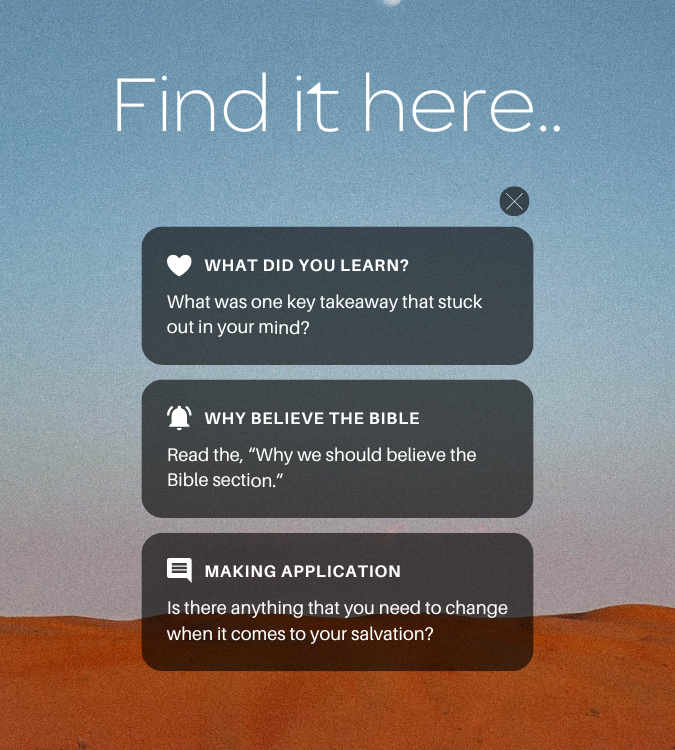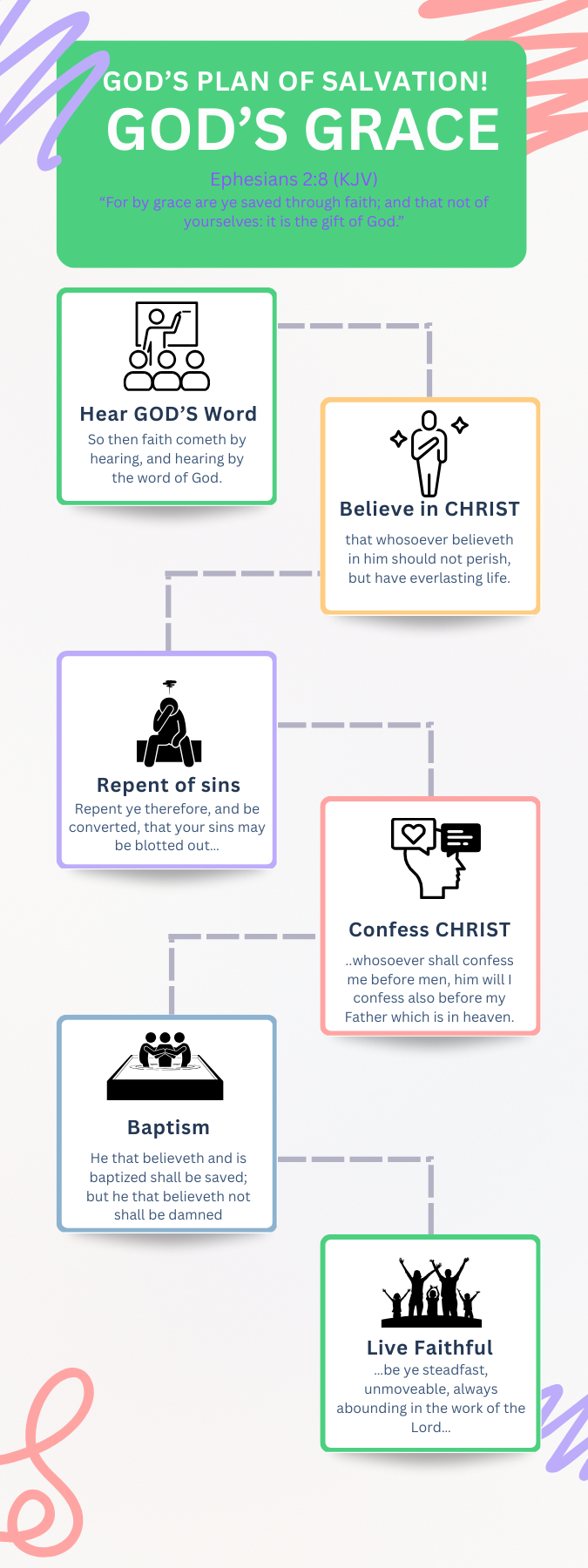What We Learn from the Video
What does true baptism look like, and why does it matter for salvation? The video “Why I Couldn’t Accept Sprinkling as Baptism” delivers a powerful message: only biblical baptism aligns with the Bible plan of salvation. The speaker shares their journey from accepting infant sprinkling to discovering the truth about baptism through Scripture. They state, “I saw that baptism was a burial. That didn’t match sprinkling.” This realization, rooted in Romans 6, led them to be baptized by immersion for the forgiveness of sins, marking “the true beginning of my Christian life.”
The main takeaway is that baptism must follow the New Testament pattern—a burial in water, not sprinkling. The speaker’s study revealed that infant sprinkling, a common denominational practice, lacks biblical basis. Instead, passages like Acts 2:38 emphasize baptism’s role in forgiveness, requiring personal faith and immersion. This aligns with the Bible way to be saved, which demands obedience to God’s Word over tradition. The video challenges viewers to examine their own baptism: was it scriptural, or a human invention? By choosing immersion, the speaker found true salvation. You can too—open your Bible to Romans 6:3-4 and Acts 22:16, and let the truth about baptism guide you to a genuine Christian life.
Why We Should Believe the Bible
The speaker’s discovery in “Why I Couldn’t Accept Sprinkling as Baptism” hinges on the Bible’s authority, as they found truth in Romans 6: “All of us who have been baptized into Christ Jesus were baptized into his death.” The trustworthiness of Scripture makes it the ultimate guide for salvation and practice. Below, we explore why the Bible is reliable, urging you to trust its authority of the Bible.
Fulfilled Prophecy
The Bible’s prophecies, like Micah 5:2 predicting Jesus’ birthplace in Bethlehem, fulfilled centuries later (Matthew 2:1), prove divine origin. Hundreds of Messianic prophecies confirm the trustworthiness of Scripture.
Historical Accuracy
Archaeological evidence, such as the Pilate Stone, verifies biblical figures and events. Secular historians like Josephus corroborate Jesus’ life and death, reinforcing the Bible’s historical reliability.
Eyewitness Testimony
The New Testament is built on accounts from those who saw Jesus’ ministry. 2 Peter 1:16 states: “We did not follow cleverly devised myths… but we were eyewitnesses of his majesty.” These firsthand reports, recorded soon after events, bolster credibility.
Divine Inspiration
The Bible claims God’s authorship. 2 Timothy 3:16 declares: “All Scripture is breathed out by God.” Its unity across diverse authors over centuries reflects divine guidance. The speaker’s reliance on Romans 6 to reject sprinkling shows Scripture’s power to reveal truth.
Trust God’s Word. The Bible’s prophecies, accuracy, testimonies, and inspiration make it the final authority. Like the speaker, who found “baptism was a burial,” you can trust the God’s Word is truth for salvation. Study Acts 2:38 and Romans 6 to embrace the authority of the Bible, ensuring your faith rests on God’s unchanging truth.
How to Apply This Truth to My Life
The video “Why I Couldn’t Accept Sprinkling as Baptism” reveals the truth about baptism as a burial, prompting the speaker to obey Scripture through immersion, marking “the true beginning of my Christian life.” To apply God’s Word to your life, follow these four steps inspired by the video to ensure Christian living reflects obedience to the gospel.
- Study Biblical Baptism. Read Romans 6:3-4 and Acts 2:38 to understand baptism as a burial for forgiveness, not sprinkling. Compare your experience to Scripture.
- Evaluate Your Baptism. The speaker realized “what I had wasn’t what the Bible taught.” Was your baptism by immersion after personal faith, or an unbiblical practice like infant sprinkling? Seek truth over tradition.
- Obey the Gospel. If your baptism doesn’t align with Scripture, follow the speaker’s example and be baptized by immersion for forgiveness (Acts 22:16). Contact a Bible-based church to act.
- Share Your Faith. After baptism, live boldly, sharing the truth about baptism with others, as the speaker’s story inspires.
Modern Scenario: Sarah, raised in a church practicing infant sprinkling, assumes she’s saved. After watching the video, she studies Romans 6 and realizes baptism requires faith and immersion. Choosing obedience to the gospel, she’s baptized as an adult, finding true peace. Her Christian living transforms—she joins a Bible study, deepening her faith. By applying these steps, you can apply God’s Word, ensuring your salvation aligns with the Bible plan of salvation, just as the speaker found a true start.
What This Denomination Teaches about Salvation
The video references a church practicing infant sprinkling, which the speaker rejected after reading Romans 6. This points to denominations like Catholicism, Lutheranism, or Presbyterianism, where sprinkling or pouring is common. Below, we explore the denominational view of salvation in such churches, focusing on the water baptism meaning, while remaining respectful yet factual, and noting differences with the New Testament.
Denominational Teaching on Salvation
In many churches practicing infant baptism, such as Catholicism or Presbyterianism, salvation often begins with baptism as a sacrament. The video notes the speaker was “sprinkled as a baby in my church and told that was my baptism.” In Catholicism, infant baptism removes original sin, initiating grace, often followed by confirmation and a life of faith. The Catechism of the Catholic Church (CCC 1250) states baptism is necessary for salvation, cleansing infants of inherited sin. Lutheranism similarly views baptism as a means of grace, where faith is imparted, even to infants (Augsburg Confession, Article IX). Presbyterians see it as a covenant sign, akin to circumcision, not always tied to immediate forgiveness but inclusion in God’s family (Westminster Confession, Chapter 28).
These denominations may not emphasize the sinner’s prayer but focus on sacraments or faith. Baptism, whether by sprinkling or pouring, is seen as sufficient, often without requiring personal belief from the recipient. Some, like Lutherans, stress faith alone (sola fide), where baptism and faith together secure salvation, citing Ephesians 2:8-9: “For by grace you have been saved through faith… not a result of works.”
New Testament Teaching on Baptism
The New Testament presents a different water baptism meaning. Romans 6:3-4, cited by the speaker, describes baptism as “a burial”: “All of us who have been baptized into Christ Jesus were baptized into his death… so we too might walk in newness of life.” This implies immersion, symbolizing burial and resurrection, requiring personal faith (Mark 16:16: “Whoever believes and is baptized will be saved”). Acts 2:38 ties baptism to forgiveness: “Repent and be baptized… for the forgiveness of your sins.” The speaker’s realization that “what I had wasn’t what the Bible taught” reflects this, as infant sprinkling lacks the believer’s faith and burial imagery. Acts 8:36-38 shows the Ethiopian eunuch baptized after believing, supporting immersion for conscious believers.
Key Differences
The denominational view of salvation often allows infant baptism by sprinkling, assuming it imparts grace without personal faith. The New Testament, however, requires belief and repentance before baptism (Acts 2:38), which infants cannot express. The truth about baptism is that it’s a burial for those who choose faith (1 Peter 3:21: “Baptism… now saves you… as an appeal to God for a good conscience”). The sinner’s prayer, sometimes used in other Protestant churches, also lacks New Testament precedent for salvation, unlike baptism’s clear mandate (Matthew 28:19-20). Respectfully, these denominations offer rich traditions but diverge from the Bible plan of salvation by altering baptism’s form and purpose.
Why This Matters
The speaker’s immersion marked their “true beginning” as a Christian, aligning with Scripture. Study Romans 6 and Acts 22:16 to ensure your salvation follows the New Testament plan of salvation. The truth about baptism calls for faith-driven immersion, not tradition-based sprinkling, securing forgiveness through obedience.
What the Bible Teaches about Salvation
The video “Why I Couldn’t Accept Sprinkling as Baptism” powerfully illustrates the need to align with Scripture, as the speaker discovered in Romans 6 that “baptism was a burial.” This realization led them to immersion “for the forgiveness of sins,” marking “the true beginning of my Christian life.” Salvation, the heart of Christianity, answers the question, “What must I do to be saved?” (Acts 16:30). The Bible way to be saved is a clear, step-by-step New Testament plan of salvation, rooted in God’s grace and our obedience. Below, we explore each step with practical, persuasive insights, ensuring your journey reflects the truth about baptism and beyond.
Step 1: Hearing the Word
Salvation starts with hearing God’s message. Romans 10:17 states: “So faith comes from hearing, and hearing through the word of Christ.” Without encountering the gospel—Jesus’ death, burial, and resurrection (1 Corinthians 15:1-4)—belief can’t form. The speaker’s transformation began by reading Romans 6, highlighting how hearing truth exposes errors like sprinkling.
Practical Explanation: Make hearing a daily habit. Read the Bible, listen to scriptural sermons, or join a study group. It’s persuasive because it builds faith amid doubt. Imagine a busy professional ignoring the gospel—they miss salvation’s hope. By hearing, you open your heart to God’s plan, the first step in the New Testament plan of salvation. Start with Acts or John to grasp Jesus’ sacrifice.
Step 2: Believing in Jesus Christ
Hearing leads to belief, trusting Jesus as Savior. Mark 16:16 declares: “Whoever believes and is baptized will be saved, but whoever does not believe will be condemned.” Belief means accepting Jesus’ atonement (John 3:16) and lordship. Hebrews 11:6 adds: “Without faith it is impossible to please him.”
Persuasive Application: Examine evidence like prophecies fulfilled in Jesus (Isaiah 53). Belief changes priorities, offering eternal purpose. Consider a skeptic: hearing the Word, they believe Jesus rose, sparking transformation. The speaker believed baptism’s burial imagery, rejecting sprinkling. In the Bible way to be saved, belief propels you forward—pray for faith, study the Gospels, and let it motivate obedience.
Step 3: Repentance from Sin
Belief demands repentance, turning from sin. Acts 2:38 commands: “Repent and be baptized every one of you in the name of Jesus Christ for the forgiveness of your sins.” Repentance is a mindset shift leading to action (2 Corinthians 7:10). Luke 13:3 warns: “Unless you repent, you will all likewise perish.”
Practical Insight: Identify sins through prayer (Psalm 139:23-24) and commit to change, perhaps with accountability. It’s persuasive—repentance frees from guilt, bringing joy (Acts 3:19). Picture someone in destructive habits: repenting, they find strength in Christ. The speaker repented of accepting unbiblical baptism, aligning with truth. This step in the New Testament plan of salvation cleanses your path for confession and baptism.
Step 4: Confession of Faith
Repentance includes confessing Jesus publicly. Romans 10:9-10 states: “If you confess with your mouth that Jesus is Lord and believe in your heart that God raised him from the dead, you will be saved.” This declaration affirms commitment, as in the eunuch’s confession (Acts 8:37).
Persuasive Explanation: Confess in church or conversations—it strengthens resolve and witnesses to others (Matthew 10:32). Imagine a timid believer: confessing bolsters their faith amid opposition. The speaker’s story implies confessing the need for biblical baptism. In the Bible way to be saved, confession bridges belief to action, preparing for baptism’s fulfillment.
Step 5: Baptism for the Remission of Sins
Baptism is where forgiveness occurs, a burial in water. Acts 2:38 links it to salvation: “Repent and be baptized… for the forgiveness of your sins.” 1 Peter 3:21 affirms: “Baptism… now saves you… as an appeal to God for a good conscience.” The truth about baptism is immersion, symbolizing death to sin (Romans 6:3-4: “All of us who have been baptized into Christ Jesus were baptized into his death… so we too might walk in newness of life”). The speaker realized sprinkling didn’t match this burial, leading to immersion as their “true beginning.”
Practical and Persuasive: Seek a Bible-teaching church for immersion after faith. It’s convincing because it unites you with Christ (Galatians 3:27), washing sins away (Acts 22:16). Unlike sprinkling, which the speaker rejected as unbiblical, immersion obeys Jesus’ command (Matthew 28:19-20). Envision an adult baptized: they emerge renewed, sins forgiven. The truth about baptism counters traditions, ensuring the New Testament plan of salvation is complete—don’t delay this vital step.
Step 6: Living Faithfully Until Death
Salvation requires ongoing faithfulness. Revelation 2:10 promises: “Be faithful unto death, and I will give you the crown of life.” This means daily obedience, fruit-bearing (John 15:8), and perseverance (James 1:12). 2 Peter 1:5-11 urges building virtues on faith.
Persuasive Application: Engage in prayer, study, and service (Hebrews 10:25). Faithfulness secures eternity, rewarding endurance. Like the speaker’s new life post-baptism, it brings purpose. Picture a believer facing trials: faithfulness sustains them. This final step in the Bible way to be saved transforms you into Christ’s likeness (Romans 8:29), completing salvation’s journey.
Heartfelt Appeal: The speaker found truth by rejecting sprinkling for biblical baptism—now it’s your turn. The New Testament plan of salvation invites you: hear, believe, repent, confess, be baptized, and live faithfully. Ask, “What must I do to be saved?” and respond today. God’s grace awaits; embrace the truth about baptism and secure eternal life.
Background of the Denomination
The video “Why I Couldn’t Accept Sprinkling as Baptism” highlights the speaker’s shift to biblical baptism, aligning with the Churches of Christ, a denomination emphasizing New Testament practices. Understanding the history of the Churches of Christ clarifies their focus on immersion for salvation.
Origins and Founders
The history of the Churches of Christ traces to the Restoration Movement in the early 19th century, led by Alexander Campbell and Barton W. Stone. Originating in the 1820s in Kentucky and Pennsylvania, this movement sought to restore first-century Christianity, rejecting denominational creeds. The 1832 unification in Lexington, Kentucky, marked the formal origin of Churches of Christ teachings, emphasizing biblical authority over tradition.
Core Doctrines
The Churches of Christ uphold sola scriptura, believer’s baptism by immersion, and a cappella worship. Their denominational view of salvation requires hearing the Word, believing, repenting, confessing, and baptism for forgiveness (Acts 2:38), followed by faithful living. The video’s focus on baptism as a “burial” (Romans 6:3-4) reflects their doctrine that immersion, not sprinkling, is essential for salvation, rooted in the truth about baptism.
Historical Context for Salvation
The Restoration Movement reacted against faith-alone doctrines and infant baptism prevalent in Protestantism. Campbell’s debates, like the 1823 debate with W.L. MacCalla, emphasized baptism’s necessity, citing Acts 2:38. This shaped the history of the denomination, prioritizing scriptural obedience. The speaker’s rejection of sprinkling mirrors this historical push for biblical fidelity.
Why It Matters: The history of the Churches of Christ underscores a commitment to the New Testament plan of salvation, urging believers to align with Scripture, as the speaker did, ensuring their baptism reflects God’s design for eternal life.
Key Bible Passages to Read and Study
The video cites Romans 6, emphasizing baptism as a burial for forgiveness, central to the Bible verses about salvation. Below are 10 Scriptures for eternal life, including the video’s reference, to guide study of the Bible way to be saved and the truth about baptism.
- Romans 6:3-4 – “All of us who have been baptized into Christ Jesus were baptized into his death… so we too might walk in newness of life.” Cited in the video, this defines baptism as a burial, not sprinkling, uniting us with Christ’s death and resurrection.
- Acts 2:38 – “Repent and be baptized… for the forgiveness of your sins.” Baptism is essential for forgiveness, a core step in salvation.
- Mark 16:16 – “Whoever believes and is baptized will be saved.” Belief and baptism together secure salvation, requiring personal faith.
- 1 Peter 3:21 – “Baptism… now saves you… as an appeal to God for a good conscience.” Baptism is a saving act, not a mere symbol.
- Acts 22:16 – “Rise and be baptized and wash away your sins.” Baptism directly washes away sins, aligning with the speaker’s immersion.
- Galatians 3:27 – “For as many of you as were baptized into Christ have put on Christ.” Baptism unites believers with Christ, essential for salvation.
- Colossians 2:12 – “Having been buried with him in baptism… you were also raised with him through faith.” Baptism mirrors Christ’s burial, requiring immersion.
- John 3:5 – “Unless one is born of water and the Spirit, he cannot enter the kingdom of God.” Water baptism is vital for entering God’s kingdom.
- Titus 3:5 – “He saved us… by the washing of regeneration and renewal of the Holy Spirit.” Baptism regenerates, tied to salvation’s promise.
- Revelation 2:10 – “Be faithful unto death, and I will give you the crown of life.” Faithfulness post-baptism ensures eternal life.
These Bible verses about salvation clarify the truth about baptism as a burial, guiding you to obey the gospel for eternal life, as the speaker did.
Common Misunderstandings about Salvation
The video “Why I Couldn’t Accept Sprinkling as Baptism” challenges common views on baptism, as the speaker discovered in Romans 6 that “baptism was a burial” and rejected sprinkling because “that didn’t match.” This highlights misconceptions about grace and false teachings about salvation, often downplaying the truth about baptism. Below, we examine four errors, correcting each with Scripture while respecting denominational perspectives. These clarifications guide seekers to the Bible way to be saved.
Faith Alone Saves, Without Actions
Many believe faith alone grants salvation, excluding obedience like baptism. This misconception about grace emphasizes Ephesians 2:8-9: “For by grace you have been saved through faith… not a result of works.” Yet, it overlooks that faith includes response. James 2:24 counters: “A person is justified by works and not by faith alone.” The speaker’s realization that their sprinkling “wasn’t what the Bible taught” implies faith demands biblical obedience. Hebrews 5:9 adds: “He became the source of eternal salvation to all who obey him.” True faith acts, aligning with the New Testament plan of salvation.
Baptism Is Optional or Symbolic
A widespread false teaching about salvation views baptism as symbolic or optional, not essential for forgiveness. Some see it as a post-salvation sign. The truth about baptism is revealed in Acts 2:38: “Repent and be baptized… for the forgiveness of your sins.” The speaker rebuts this by noting sprinkling didn’t match the burial in Romans 6, leading to immersion “for the forgiveness of sins.” 1 Peter 3:21 clarifies: “Baptism… now saves you, not as a removal of dirt from the body but as an appeal to God for a good conscience.” Baptism is a saving act, not optional.
Salvation Happens Before Baptism
Relatedly, some claim salvation occurs at belief, with baptism as confirmation later. This misconception about grace cites the thief on the cross (Luke 23:43), unbaptized yet saved. However, the New Covenant began after Jesus’ death (Hebrews 9:16-17). Mark 16:16 states: “Whoever believes and is baptized will be saved.” The speaker’s experience shows baptism’s necessity, as immersion marked their “true beginning of my Christian life.” Galatians 3:27 reinforces: “For as many of you as were baptized into Christ have put on Christ.” Salvation’s fullness requires baptism.
Universalism—Everyone Is Saved
Universalism teaches all achieve salvation, regardless of response, due to God’s love. This false teaching about salvation ignores personal accountability. Matthew 7:13-14 warns: “Enter by the narrow gate. For the gate is wide… that leads to destruction, and those who enter by it are many.” The speaker’s urgent obedience to biblical baptism implies salvation demands action. Romans 6:23 declares: “The wages of sin is death, but the free gift of God is eternal life in Christ Jesus our Lord.” Eternal life comes through faith and obedience, not universally.
These corrections dispel misconceptions about grace, revealing the truth about baptism as integral to salvation. Study Romans 6 and Acts 2:38 to align with God’s plan.
Real-Life Examples of Changed Lives
The video’s focus on the truth about baptism inspires Christian testimony accounts of individuals who embraced the gospel, leading to a changed life through the gospel. Below are two stories reflecting the speaker’s journey from sprinkling to immersion.
Rachel’s Path to Biblical Baptism
Rachel was sprinkled as an infant, taught it was her baptism. Doubts lingered until she read Romans 6, echoing the speaker’s realization: “That didn’t match sprinkling.” Studying Acts 2:38, she saw baptism’s role in forgiveness. Rachel repented and was immersed, finding peace. Her Christian testimony shines: “Obeying the gospel gave me a true start, just like the video.” Now, she leads Bible studies, helping others discover the New Testament plan of salvation, her life transformed by scriptural obedience.
Mark’s Redemption Through Obedience
Mark grew up in a church emphasizing faith alone, ignoring baptism’s burial. A friend shared Acts 22:16, prompting him to study. Like the speaker, who found “baptism was a burial,” Mark chose immersion, breaking free from guilt. His changed life through the gospel is evident: “Immersion was my new beginning.” He now mentors youth, sharing the truth about baptism, inspiring others to follow God’s Word. His faith, once shaky, is now steadfast, rooted in obedience.
These stories mirror the speaker’s shift to immersion for forgiveness, showing how the Bible way to be saved transforms lives. Rachel and Mark, like the speaker, found freedom by aligning with Scripture, not tradition. You can experience this too—open your Bible, study Romans 6, and obey the gospel. Just as the speaker’s immersion marked “the true beginning of my Christian life,” your obedience can spark a new, eternal journey filled with God’s peace.
Why Urgency Matters in Responding to the Gospel
The video “Why I Couldn’t Accept Sprinkling as Baptism” emphasizes the urgency of salvation, as the speaker, upon realizing “baptism was a burial” (Romans 6:3-4), acted swiftly to be immersed “for the forgiveness of sins.” This decisive step marked “the true beginning of my Christian life.” Salvation isn’t a decision to postpone—Scripture and the speaker’s example stress that today is the day to obey. Delaying risks eternal loss, as life is fleeting and God’s call is immediate. Below, we explore why you must do not delay obeying the gospel, using biblical truths to urge immediate action.
Life’s Fragility Demands Prompt Action
Life’s uncertainty underscores the urgency of salvation. James 4:14 warns: “You do not know what tomorrow will bring. What is your life? For you are a mist that appears for a little time and then vanishes.” A sudden event could close your opportunity to obey. The speaker didn’t wait after discovering sprinkling “didn’t match” Scripture—they pursued biblical baptism. Practically, this means studying Acts 2:38 and seeking immersion now. Persuasive? Absolutely—tomorrow isn’t guaranteed. Imagine assuming you have years, only to face eternity unprepared. Today is the day to align with the Bible way to be saved, ensuring your soul’s security.
God’s Invitation Is Now
Scripture frames salvation as an immediate call. 2 Corinthians 6:2 declares: “Behold, now is the favorable time; behold, now is the day of salvation.” The speaker’s prompt immersion reflects this urgency, acting once they saw the truth about baptism. Hebrews 3:15 adds: “Today, if you hear his voice, do not harden your hearts.” Delaying risks spiritual resistance. Practically, read Romans 6 or contact AreUSaved.com for guidance. The urgency of salvation lies in God’s open invitation—don’t wait, as hesitation could dull your heart to truth.
Eternal Consequences Are at Stake
The stakes of delay are eternal. Revelation 22:12 states: “Behold, I am coming soon, bringing my recompense with me.” The speaker’s baptism marked a “true beginning,” implying urgency to obey before it’s too late. Acts 22:16 urges: “Why are you waiting? Rise and be baptized and wash away your sins.” Matthew 25:46 contrasts “eternal punishment” with “eternal life” for the obedient. Persuasive? Salvation’s outcome is forever—delaying risks loss. The New Testament plan of salvation requires immediate response, as the speaker showed by acting on truth.
Act Today for Eternal Peace
The video’s message is clear: do not delay obeying the gospel. The speaker’s shift from sprinkling to immersion shows the power of acting on Scripture. Study Mark 16:16, believe, repent, confess, and be baptized now. Visit AreUSaved.com for a free Bible study to start. 2 Peter 3:9 shows God’s patience, but don’t test it. Picture ignoring a warning sign—delaying the gospel is riskier. Today is the day to obey, ensuring your eternity. The speaker found freedom in biblical baptism; you can find that peace too by responding now.
Questions to Ask Yourself After Watching
The video “Why I Couldn’t Accept Sprinkling as Baptism” urges viewers to align with Scripture, as the speaker realized “what I had wasn’t what the Bible taught.” This prompts deep reflection on your eternal destiny. Below are six questions to examine your faith and ensure it reflects the Bible truth about salvation.
- Am I saved by God’s standard? Does your baptism match the burial described in Romans 6:3-4, or was it sprinkling, like the speaker’s?
- Is my baptism biblical? The speaker found “baptism was a burial.” Was yours by immersion after personal faith (Acts 2:38)?
- Do I trust Scripture over tradition? Are you relying on church practices, or studying the Bible yourself to confirm the truth about baptism?
- Have I obeyed the full gospel? Have you believed, repented, confessed, and been immersed, as the New Testament plan of salvation requires (Mark 16:16)?
- What holds me back from acting? If your baptism doesn’t align with Scripture, why delay immersion, as the speaker did for their “true beginning”?
- Is my eternal destiny secure? If today were your last, would your obedience to the gospel ensure salvation (Revelation 2:10)?
These questions, inspired by the speaker’s journey, challenge you to seek truth. Don’t let tradition obscure the Bible truth about salvation—study Romans 6 and Acts 22:16 to ensure your eternal destiny is grounded in God’s Word.
Next Steps for Learning More
The speaker’s choice to be immersed “for the forgiveness of sins” is a call to action. To learn how to be saved and embrace the truth about baptism, take these steps to deepen your faith.
Join a Free Bible Study. Dive into Romans 6:3-4 and Acts 2:38 through AreUSaved.com’s free Bible study resources. Study alone or with a group to grasp the Bible way to be saved.
Explore More Articles. AreUSaved.com offers articles on baptism, salvation, and obedience, expanding on the video’s message that “baptism was a burial.” These clarify the gospel’s call.
Connect for Guidance. Questions about baptism or salvation? Use the AreUSaved.com chatbot or contact page for biblical answers, helping you follow the speaker’s path to immersion.
Act Today. The speaker’s “true beginning” came through obeying Scripture. Don’t wait—visit AreUSaved.com to start your journey. Study, obey, and secure your salvation through the New Testament plan of salvation. Your path to eternal life begins now.
What We Learn from the Video
What does true baptism look like, and why does it matter for salvation? The video “Why I Couldn’t Accept Sprinkling as Baptism” delivers a powerful message: only biblical baptism aligns with the Bible plan of salvation. The speaker shares their journey from accepting infant sprinkling to discovering the truth about baptism through Scripture. They state, “I saw that baptism was a burial. That didn’t match sprinkling.” This realization, rooted in Romans 6, led them to be baptized by immersion for the forgiveness of sins, marking “the true beginning of my Christian life.”
The main takeaway is that baptism must follow the New Testament pattern—a burial in water, not sprinkling. The speaker’s study revealed that infant sprinkling, a common denominational practice, lacks biblical basis. Instead, passages like Acts 2:38 emphasize baptism’s role in forgiveness, requiring personal faith and immersion. This aligns with the Bible way to be saved, which demands obedience to God’s Word over tradition. The video challenges viewers to examine their own baptism: was it scriptural, or a human invention? By choosing immersion, the speaker found true salvation. You can too—open your Bible to Romans 6:3-4 and Acts 22:16, and let the truth about baptism guide you to a genuine Christian life.
Why We Should Believe the Bible
The speaker’s discovery in “Why I Couldn’t Accept Sprinkling as Baptism” hinges on the Bible’s authority, as they found truth in Romans 6: “All of us who have been baptized into Christ Jesus were baptized into his death.” The trustworthiness of Scripture makes it the ultimate guide for salvation and practice. Below, we explore why the Bible is reliable, urging you to trust its authority of the Bible.
Fulfilled Prophecy
The Bible’s prophecies, like Micah 5:2 predicting Jesus’ birthplace in Bethlehem, fulfilled centuries later (Matthew 2:1), prove divine origin. Hundreds of Messianic prophecies confirm the trustworthiness of Scripture.
Historical Accuracy
Archaeological evidence, such as the Pilate Stone, verifies biblical figures and events. Secular historians like Josephus corroborate Jesus’ life and death, reinforcing the Bible’s historical reliability.
Eyewitness Testimony
The New Testament is built on accounts from those who saw Jesus’ ministry. 2 Peter 1:16 states: “We did not follow cleverly devised myths… but we were eyewitnesses of his majesty.” These firsthand reports, recorded soon after events, bolster credibility.
Divine Inspiration
The Bible claims God’s authorship. 2 Timothy 3:16 declares: “All Scripture is breathed out by God.” Its unity across diverse authors over centuries reflects divine guidance. The speaker’s reliance on Romans 6 to reject sprinkling shows Scripture’s power to reveal truth.
Trust God’s Word. The Bible’s prophecies, accuracy, testimonies, and inspiration make it the final authority. Like the speaker, who found “baptism was a burial,” you can trust the God’s Word is truth for salvation. Study Acts 2:38 and Romans 6 to embrace the authority of the Bible, ensuring your faith rests on God’s unchanging truth.
How to Apply This Truth to My Life
The video “Why I Couldn’t Accept Sprinkling as Baptism” reveals the truth about baptism as a burial, prompting the speaker to obey Scripture through immersion, marking “the true beginning of my Christian life.” To apply God’s Word to your life, follow these four steps inspired by the video to ensure Christian living reflects obedience to the gospel.
- Study Biblical Baptism. Read Romans 6:3-4 and Acts 2:38 to understand baptism as a burial for forgiveness, not sprinkling. Compare your experience to Scripture.
- Evaluate Your Baptism. The speaker realized “what I had wasn’t what the Bible taught.” Was your baptism by immersion after personal faith, or an unbiblical practice like infant sprinkling? Seek truth over tradition.
- Obey the Gospel. If your baptism doesn’t align with Scripture, follow the speaker’s example and be baptized by immersion for forgiveness (Acts 22:16). Contact a Bible-based church to act.
- Share Your Faith. After baptism, live boldly, sharing the truth about baptism with others, as the speaker’s story inspires.
Modern Scenario: Sarah, raised in a church practicing infant sprinkling, assumes she’s saved. After watching the video, she studies Romans 6 and realizes baptism requires faith and immersion. Choosing obedience to the gospel, she’s baptized as an adult, finding true peace. Her Christian living transforms—she joins a Bible study, deepening her faith. By applying these steps, you can apply God’s Word, ensuring your salvation aligns with the Bible plan of salvation, just as the speaker found a true start.
What This Denomination Teaches about Salvation
The video references a church practicing infant sprinkling, which the speaker rejected after reading Romans 6. This points to denominations like Catholicism, Lutheranism, or Presbyterianism, where sprinkling or pouring is common. Below, we explore the denominational view of salvation in such churches, focusing on the water baptism meaning, while remaining respectful yet factual, and noting differences with the New Testament.
Denominational Teaching on Salvation
In many churches practicing infant baptism, such as Catholicism or Presbyterianism, salvation often begins with baptism as a sacrament. The video notes the speaker was “sprinkled as a baby in my church and told that was my baptism.” In Catholicism, infant baptism removes original sin, initiating grace, often followed by confirmation and a life of faith. The Catechism of the Catholic Church (CCC 1250) states baptism is necessary for salvation, cleansing infants of inherited sin. Lutheranism similarly views baptism as a means of grace, where faith is imparted, even to infants (Augsburg Confession, Article IX). Presbyterians see it as a covenant sign, akin to circumcision, not always tied to immediate forgiveness but inclusion in God’s family (Westminster Confession, Chapter 28).
These denominations may not emphasize the sinner’s prayer but focus on sacraments or faith. Baptism, whether by sprinkling or pouring, is seen as sufficient, often without requiring personal belief from the recipient. Some, like Lutherans, stress faith alone (sola fide), where baptism and faith together secure salvation, citing Ephesians 2:8-9: “For by grace you have been saved through faith… not a result of works.”
New Testament Teaching on Baptism
The New Testament presents a different water baptism meaning. Romans 6:3-4, cited by the speaker, describes baptism as “a burial”: “All of us who have been baptized into Christ Jesus were baptized into his death… so we too might walk in newness of life.” This implies immersion, symbolizing burial and resurrection, requiring personal faith (Mark 16:16: “Whoever believes and is baptized will be saved”). Acts 2:38 ties baptism to forgiveness: “Repent and be baptized… for the forgiveness of your sins.” The speaker’s realization that “what I had wasn’t what the Bible taught” reflects this, as infant sprinkling lacks the believer’s faith and burial imagery. Acts 8:36-38 shows the Ethiopian eunuch baptized after believing, supporting immersion for conscious believers.
Key Differences
The denominational view of salvation often allows infant baptism by sprinkling, assuming it imparts grace without personal faith. The New Testament, however, requires belief and repentance before baptism (Acts 2:38), which infants cannot express. The truth about baptism is that it’s a burial for those who choose faith (1 Peter 3:21: “Baptism… now saves you… as an appeal to God for a good conscience”). The sinner’s prayer, sometimes used in other Protestant churches, also lacks New Testament precedent for salvation, unlike baptism’s clear mandate (Matthew 28:19-20). Respectfully, these denominations offer rich traditions but diverge from the Bible plan of salvation by altering baptism’s form and purpose.
Why This Matters
The speaker’s immersion marked their “true beginning” as a Christian, aligning with Scripture. Study Romans 6 and Acts 22:16 to ensure your salvation follows the New Testament plan of salvation. The truth about baptism calls for faith-driven immersion, not tradition-based sprinkling, securing forgiveness through obedience.
What the Bible Teaches about Salvation
The video “Why I Couldn’t Accept Sprinkling as Baptism” powerfully illustrates the need to align with Scripture, as the speaker discovered in Romans 6 that “baptism was a burial.” This realization led them to immersion “for the forgiveness of sins,” marking “the true beginning of my Christian life.” Salvation, the heart of Christianity, answers the question, “What must I do to be saved?” (Acts 16:30). The Bible way to be saved is a clear, step-by-step New Testament plan of salvation, rooted in God’s grace and our obedience. Below, we explore each step with practical, persuasive insights, ensuring your journey reflects the truth about baptism and beyond.
Step 1: Hearing the Word
Salvation starts with hearing God’s message. Romans 10:17 states: “So faith comes from hearing, and hearing through the word of Christ.” Without encountering the gospel—Jesus’ death, burial, and resurrection (1 Corinthians 15:1-4)—belief can’t form. The speaker’s transformation began by reading Romans 6, highlighting how hearing truth exposes errors like sprinkling.
Practical Explanation: Make hearing a daily habit. Read the Bible, listen to scriptural sermons, or join a study group. It’s persuasive because it builds faith amid doubt. Imagine a busy professional ignoring the gospel—they miss salvation’s hope. By hearing, you open your heart to God’s plan, the first step in the New Testament plan of salvation. Start with Acts or John to grasp Jesus’ sacrifice.
Step 2: Believing in Jesus Christ
Hearing leads to belief, trusting Jesus as Savior. Mark 16:16 declares: “Whoever believes and is baptized will be saved, but whoever does not believe will be condemned.” Belief means accepting Jesus’ atonement (John 3:16) and lordship. Hebrews 11:6 adds: “Without faith it is impossible to please him.”
Persuasive Application: Examine evidence like prophecies fulfilled in Jesus (Isaiah 53). Belief changes priorities, offering eternal purpose. Consider a skeptic: hearing the Word, they believe Jesus rose, sparking transformation. The speaker believed baptism’s burial imagery, rejecting sprinkling. In the Bible way to be saved, belief propels you forward—pray for faith, study the Gospels, and let it motivate obedience.
Step 3: Repentance from Sin
Belief demands repentance, turning from sin. Acts 2:38 commands: “Repent and be baptized every one of you in the name of Jesus Christ for the forgiveness of your sins.” Repentance is a mindset shift leading to action (2 Corinthians 7:10). Luke 13:3 warns: “Unless you repent, you will all likewise perish.”
Practical Insight: Identify sins through prayer (Psalm 139:23-24) and commit to change, perhaps with accountability. It’s persuasive—repentance frees from guilt, bringing joy (Acts 3:19). Picture someone in destructive habits: repenting, they find strength in Christ. The speaker repented of accepting unbiblical baptism, aligning with truth. This step in the New Testament plan of salvation cleanses your path for confession and baptism.
Step 4: Confession of Faith
Repentance includes confessing Jesus publicly. Romans 10:9-10 states: “If you confess with your mouth that Jesus is Lord and believe in your heart that God raised him from the dead, you will be saved.” This declaration affirms commitment, as in the eunuch’s confession (Acts 8:37).
Persuasive Explanation: Confess in church or conversations—it strengthens resolve and witnesses to others (Matthew 10:32). Imagine a timid believer: confessing bolsters their faith amid opposition. The speaker’s story implies confessing the need for biblical baptism. In the Bible way to be saved, confession bridges belief to action, preparing for baptism’s fulfillment.
Step 5: Baptism for the Remission of Sins
Baptism is where forgiveness occurs, a burial in water. Acts 2:38 links it to salvation: “Repent and be baptized… for the forgiveness of your sins.” 1 Peter 3:21 affirms: “Baptism… now saves you… as an appeal to God for a good conscience.” The truth about baptism is immersion, symbolizing death to sin (Romans 6:3-4: “All of us who have been baptized into Christ Jesus were baptized into his death… so we too might walk in newness of life”). The speaker realized sprinkling didn’t match this burial, leading to immersion as their “true beginning.”
Practical and Persuasive: Seek a Bible-teaching church for immersion after faith. It’s convincing because it unites you with Christ (Galatians 3:27), washing sins away (Acts 22:16). Unlike sprinkling, which the speaker rejected as unbiblical, immersion obeys Jesus’ command (Matthew 28:19-20). Envision an adult baptized: they emerge renewed, sins forgiven. The truth about baptism counters traditions, ensuring the New Testament plan of salvation is complete—don’t delay this vital step.
Step 6: Living Faithfully Until Death
Salvation requires ongoing faithfulness. Revelation 2:10 promises: “Be faithful unto death, and I will give you the crown of life.” This means daily obedience, fruit-bearing (John 15:8), and perseverance (James 1:12). 2 Peter 1:5-11 urges building virtues on faith.
Persuasive Application: Engage in prayer, study, and service (Hebrews 10:25). Faithfulness secures eternity, rewarding endurance. Like the speaker’s new life post-baptism, it brings purpose. Picture a believer facing trials: faithfulness sustains them. This final step in the Bible way to be saved transforms you into Christ’s likeness (Romans 8:29), completing salvation’s journey.
Heartfelt Appeal: The speaker found truth by rejecting sprinkling for biblical baptism—now it’s your turn. The New Testament plan of salvation invites you: hear, believe, repent, confess, be baptized, and live faithfully. Ask, “What must I do to be saved?” and respond today. God’s grace awaits; embrace the truth about baptism and secure eternal life.
Background of the Denomination
The video “Why I Couldn’t Accept Sprinkling as Baptism” highlights the speaker’s shift to biblical baptism, aligning with the Churches of Christ, a denomination emphasizing New Testament practices. Understanding the history of the Churches of Christ clarifies their focus on immersion for salvation.
Origins and Founders
The history of the Churches of Christ traces to the Restoration Movement in the early 19th century, led by Alexander Campbell and Barton W. Stone. Originating in the 1820s in Kentucky and Pennsylvania, this movement sought to restore first-century Christianity, rejecting denominational creeds. The 1832 unification in Lexington, Kentucky, marked the formal origin of Churches of Christ teachings, emphasizing biblical authority over tradition.
Core Doctrines
The Churches of Christ uphold sola scriptura, believer’s baptism by immersion, and a cappella worship. Their denominational view of salvation requires hearing the Word, believing, repenting, confessing, and baptism for forgiveness (Acts 2:38), followed by faithful living. The video’s focus on baptism as a “burial” (Romans 6:3-4) reflects their doctrine that immersion, not sprinkling, is essential for salvation, rooted in the truth about baptism.
Historical Context for Salvation
The Restoration Movement reacted against faith-alone doctrines and infant baptism prevalent in Protestantism. Campbell’s debates, like the 1823 debate with W.L. MacCalla, emphasized baptism’s necessity, citing Acts 2:38. This shaped the history of the denomination, prioritizing scriptural obedience. The speaker’s rejection of sprinkling mirrors this historical push for biblical fidelity.
Why It Matters: The history of the Churches of Christ underscores a commitment to the New Testament plan of salvation, urging believers to align with Scripture, as the speaker did, ensuring their baptism reflects God’s design for eternal life.
Key Bible Passages to Read and Study
The video cites Romans 6, emphasizing baptism as a burial for forgiveness, central to the Bible verses about salvation. Below are 10 Scriptures for eternal life, including the video’s reference, to guide study of the Bible way to be saved and the truth about baptism.
- Romans 6:3-4 – “All of us who have been baptized into Christ Jesus were baptized into his death… so we too might walk in newness of life.” Cited in the video, this defines baptism as a burial, not sprinkling, uniting us with Christ’s death and resurrection.
- Acts 2:38 – “Repent and be baptized… for the forgiveness of your sins.” Baptism is essential for forgiveness, a core step in salvation.
- Mark 16:16 – “Whoever believes and is baptized will be saved.” Belief and baptism together secure salvation, requiring personal faith.
- 1 Peter 3:21 – “Baptism… now saves you… as an appeal to God for a good conscience.” Baptism is a saving act, not a mere symbol.
- Acts 22:16 – “Rise and be baptized and wash away your sins.” Baptism directly washes away sins, aligning with the speaker’s immersion.
- Galatians 3:27 – “For as many of you as were baptized into Christ have put on Christ.” Baptism unites believers with Christ, essential for salvation.
- Colossians 2:12 – “Having been buried with him in baptism… you were also raised with him through faith.” Baptism mirrors Christ’s burial, requiring immersion.
- John 3:5 – “Unless one is born of water and the Spirit, he cannot enter the kingdom of God.” Water baptism is vital for entering God’s kingdom.
- Titus 3:5 – “He saved us… by the washing of regeneration and renewal of the Holy Spirit.” Baptism regenerates, tied to salvation’s promise.
- Revelation 2:10 – “Be faithful unto death, and I will give you the crown of life.” Faithfulness post-baptism ensures eternal life.
These Bible verses about salvation clarify the truth about baptism as a burial, guiding you to obey the gospel for eternal life, as the speaker did.
Common Misunderstandings about Salvation
The video “Why I Couldn’t Accept Sprinkling as Baptism” challenges common views on baptism, as the speaker discovered in Romans 6 that “baptism was a burial” and rejected sprinkling because “that didn’t match.” This highlights misconceptions about grace and false teachings about salvation, often downplaying the truth about baptism. Below, we examine four errors, correcting each with Scripture while respecting denominational perspectives. These clarifications guide seekers to the Bible way to be saved.
Faith Alone Saves, Without Actions
Many believe faith alone grants salvation, excluding obedience like baptism. This misconception about grace emphasizes Ephesians 2:8-9: “For by grace you have been saved through faith… not a result of works.” Yet, it overlooks that faith includes response. James 2:24 counters: “A person is justified by works and not by faith alone.” The speaker’s realization that their sprinkling “wasn’t what the Bible taught” implies faith demands biblical obedience. Hebrews 5:9 adds: “He became the source of eternal salvation to all who obey him.” True faith acts, aligning with the New Testament plan of salvation.
Baptism Is Optional or Symbolic
A widespread false teaching about salvation views baptism as symbolic or optional, not essential for forgiveness. Some see it as a post-salvation sign. The truth about baptism is revealed in Acts 2:38: “Repent and be baptized… for the forgiveness of your sins.” The speaker rebuts this by noting sprinkling didn’t match the burial in Romans 6, leading to immersion “for the forgiveness of sins.” 1 Peter 3:21 clarifies: “Baptism… now saves you, not as a removal of dirt from the body but as an appeal to God for a good conscience.” Baptism is a saving act, not optional.
Salvation Happens Before Baptism
Relatedly, some claim salvation occurs at belief, with baptism as confirmation later. This misconception about grace cites the thief on the cross (Luke 23:43), unbaptized yet saved. However, the New Covenant began after Jesus’ death (Hebrews 9:16-17). Mark 16:16 states: “Whoever believes and is baptized will be saved.” The speaker’s experience shows baptism’s necessity, as immersion marked their “true beginning of my Christian life.” Galatians 3:27 reinforces: “For as many of you as were baptized into Christ have put on Christ.” Salvation’s fullness requires baptism.
Universalism—Everyone Is Saved
Universalism teaches all achieve salvation, regardless of response, due to God’s love. This false teaching about salvation ignores personal accountability. Matthew 7:13-14 warns: “Enter by the narrow gate. For the gate is wide… that leads to destruction, and those who enter by it are many.” The speaker’s urgent obedience to biblical baptism implies salvation demands action. Romans 6:23 declares: “The wages of sin is death, but the free gift of God is eternal life in Christ Jesus our Lord.” Eternal life comes through faith and obedience, not universally.
These corrections dispel misconceptions about grace, revealing the truth about baptism as integral to salvation. Study Romans 6 and Acts 2:38 to align with God’s plan.
Real-Life Examples of Changed Lives
The video’s focus on the truth about baptism inspires Christian testimony accounts of individuals who embraced the gospel, leading to a changed life through the gospel. Below are two stories reflecting the speaker’s journey from sprinkling to immersion.
Rachel’s Path to Biblical Baptism
Rachel was sprinkled as an infant, taught it was her baptism. Doubts lingered until she read Romans 6, echoing the speaker’s realization: “That didn’t match sprinkling.” Studying Acts 2:38, she saw baptism’s role in forgiveness. Rachel repented and was immersed, finding peace. Her Christian testimony shines: “Obeying the gospel gave me a true start, just like the video.” Now, she leads Bible studies, helping others discover the New Testament plan of salvation, her life transformed by scriptural obedience.
Mark’s Redemption Through Obedience
Mark grew up in a church emphasizing faith alone, ignoring baptism’s burial. A friend shared Acts 22:16, prompting him to study. Like the speaker, who found “baptism was a burial,” Mark chose immersion, breaking free from guilt. His changed life through the gospel is evident: “Immersion was my new beginning.” He now mentors youth, sharing the truth about baptism, inspiring others to follow God’s Word. His faith, once shaky, is now steadfast, rooted in obedience.
These stories mirror the speaker’s shift to immersion for forgiveness, showing how the Bible way to be saved transforms lives. Rachel and Mark, like the speaker, found freedom by aligning with Scripture, not tradition. You can experience this too—open your Bible, study Romans 6, and obey the gospel. Just as the speaker’s immersion marked “the true beginning of my Christian life,” your obedience can spark a new, eternal journey filled with God’s peace.
Why Urgency Matters in Responding to the Gospel
The video “Why I Couldn’t Accept Sprinkling as Baptism” emphasizes the urgency of salvation, as the speaker, upon realizing “baptism was a burial” (Romans 6:3-4), acted swiftly to be immersed “for the forgiveness of sins.” This decisive step marked “the true beginning of my Christian life.” Salvation isn’t a decision to postpone—Scripture and the speaker’s example stress that today is the day to obey. Delaying risks eternal loss, as life is fleeting and God’s call is immediate. Below, we explore why you must do not delay obeying the gospel, using biblical truths to urge immediate action.
Life’s Fragility Demands Prompt Action
Life’s uncertainty underscores the urgency of salvation. James 4:14 warns: “You do not know what tomorrow will bring. What is your life? For you are a mist that appears for a little time and then vanishes.” A sudden event could close your opportunity to obey. The speaker didn’t wait after discovering sprinkling “didn’t match” Scripture—they pursued biblical baptism. Practically, this means studying Acts 2:38 and seeking immersion now. Persuasive? Absolutely—tomorrow isn’t guaranteed. Imagine assuming you have years, only to face eternity unprepared. Today is the day to align with the Bible way to be saved, ensuring your soul’s security.
God’s Invitation Is Now
Scripture frames salvation as an immediate call. 2 Corinthians 6:2 declares: “Behold, now is the favorable time; behold, now is the day of salvation.” The speaker’s prompt immersion reflects this urgency, acting once they saw the truth about baptism. Hebrews 3:15 adds: “Today, if you hear his voice, do not harden your hearts.” Delaying risks spiritual resistance. Practically, read Romans 6 or contact AreUSaved.com for guidance. The urgency of salvation lies in God’s open invitation—don’t wait, as hesitation could dull your heart to truth.
Eternal Consequences Are at Stake
The stakes of delay are eternal. Revelation 22:12 states: “Behold, I am coming soon, bringing my recompense with me.” The speaker’s baptism marked a “true beginning,” implying urgency to obey before it’s too late. Acts 22:16 urges: “Why are you waiting? Rise and be baptized and wash away your sins.” Matthew 25:46 contrasts “eternal punishment” with “eternal life” for the obedient. Persuasive? Salvation’s outcome is forever—delaying risks loss. The New Testament plan of salvation requires immediate response, as the speaker showed by acting on truth.
Act Today for Eternal Peace
The video’s message is clear: do not delay obeying the gospel. The speaker’s shift from sprinkling to immersion shows the power of acting on Scripture. Study Mark 16:16, believe, repent, confess, and be baptized now. Visit AreUSaved.com for a free Bible study to start. 2 Peter 3:9 shows God’s patience, but don’t test it. Picture ignoring a warning sign—delaying the gospel is riskier. Today is the day to obey, ensuring your eternity. The speaker found freedom in biblical baptism; you can find that peace too by responding now.
Questions to Ask Yourself After Watching
The video “Why I Couldn’t Accept Sprinkling as Baptism” urges viewers to align with Scripture, as the speaker realized “what I had wasn’t what the Bible taught.” This prompts deep reflection on your eternal destiny. Below are six questions to examine your faith and ensure it reflects the Bible truth about salvation.
- Am I saved by God’s standard? Does your baptism match the burial described in Romans 6:3-4, or was it sprinkling, like the speaker’s?
- Is my baptism biblical? The speaker found “baptism was a burial.” Was yours by immersion after personal faith (Acts 2:38)?
- Do I trust Scripture over tradition? Are you relying on church practices, or studying the Bible yourself to confirm the truth about baptism?
- Have I obeyed the full gospel? Have you believed, repented, confessed, and been immersed, as the New Testament plan of salvation requires (Mark 16:16)?
- What holds me back from acting? If your baptism doesn’t align with Scripture, why delay immersion, as the speaker did for their “true beginning”?
- Is my eternal destiny secure? If today were your last, would your obedience to the gospel ensure salvation (Revelation 2:10)?
These questions, inspired by the speaker’s journey, challenge you to seek truth. Don’t let tradition obscure the Bible truth about salvation—study Romans 6 and Acts 22:16 to ensure your eternal destiny is grounded in God’s Word.
Next Steps for Learning More
The speaker’s choice to be immersed “for the forgiveness of sins” is a call to action. To learn how to be saved and embrace the truth about baptism, take these steps to deepen your faith.
Join a Free Bible Study. Dive into Romans 6:3-4 and Acts 2:38 through AreUSaved.com’s free Bible study resources. Study alone or with a group to grasp the Bible way to be saved.
Explore More Articles. AreUSaved.com offers articles on baptism, salvation, and obedience, expanding on the video’s message that “baptism was a burial.” These clarify the gospel’s call.
Connect for Guidance. Questions about baptism or salvation? Use the AreUSaved.com chatbot or contact page for biblical answers, helping you follow the speaker’s path to immersion.
Act Today. The speaker’s “true beginning” came through obeying Scripture. Don’t wait—visit AreUSaved.com to start your journey. Study, obey, and secure your salvation through the New Testament plan of salvation. Your path to eternal life begins now.





































.png)


.png)
.png)
.png)










